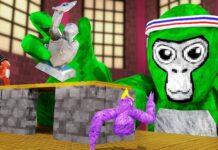User-Generated Content in Virtual Reality:
A Deep Dive into Skyrim VR, Pavlov, and VRChat
Virtual reality (VR) has emerged as an increasingly popular platform for immersive gaming and social experiences, with user-generated content (UGC) playing a crucial role in enriching and diversifying these experiences. This research paper explores the impact of UGC in VR, focusing on modifications (mods) for Skyrim VR and Pavlov, as well as avatars and maps for VRChat, and examines the benefits and challenges presented by UGC in these specific applications. The paper also discusses the implications of UGC in the broader context of VR and extended reality (XR) technologies, as the rise of UGC has transformed the way users interact with and shape their virtual environments.
Skyrim VR, a virtual reality adaptation of the popular role-playing game, The Elder Scrolls V: Skyrim, has become a prime example of user-generated content’s impact on virtual reality experiences. Initially released in 2011, Skyrim’s modding community has consistently created and shared modifications to improve the game’s visuals, gameplay mechanics, and overall experience. With the introduction of Skyrim VR in 2018, mod creators quickly began adapting their modifications to the VR platform, thereby enhancing the immersive experience. The scope of Skyrim modding is immense, with over 125k+ mods released across Skyrim’s multiple editions, and nearly 5 billion downloads, according to nexus mods, a mod hosting website.
Mods for Skyrim VR range from graphical improvements and bug fixes to entirely new quests and gameplay mechanics. This extensive customization allows users to tailor their gameplay experience according to their preferences. Notably, the modding community has addressed many of the limitations inherent in the original VR release, such as the absence of room-scale interactions and the presence of artificial locomotion mechanics, which can induce motion sickness. By enabling users to create and modify content to suit their needs, the modding community has transformed Skyrim VR into a more engaging and accessible experience.
Some of the most popular user-generated mods for Skyrim VR include graphical enhancements, such as the Static Mesh Improvement Mod (SMIM), which replaces many of the game’s meshes with more detailed and visually appealing versions. Another popular graphical mod is the Skyrim Flora Overhaul, which significantly improves the game’s vegetation and creates a more realistic and immersive environment. Technically, these mods function by replacing the game’s original textures and 3D models with higher-quality alternatives using Skyrim’s Creation Engine, which is effectively the game’s SDK. In terms of gameplay mechanics, mods like the VRIK Player Avatar introduce full-body avatars, inverse kinematics, and realistic weapon holsters, which enhance immersion by providing more accurate body and weapon movement within the virtual environment. This mod achieves this by leveraging inverse kinematics algorithms to calculate the position and orientation of the player’s virtual body based on the tracked positions of the headset and controllers.
Pavlov, a VR first-person shooter, has also garnered a sizable following and a dedicated modding community. While the base game offers a limited number of maps and game modes, UGC has expanded the range of available experiences significantly. Custom maps created by the community include adaptations of popular maps from other games, such as Counter-Strike, Halo, and Call of Duty, as well as entirely new and original designs. Furthermore, custom game modes have introduced new gameplay elements and mechanics, providing players with an ever-evolving selection of experiences. Both also may include a bevy of new interactive objects, such as new player models, weapons, and vehicles.
Pavlov’s most popular user-generated content includes custom maps and game modes that expand the game’s offerings. One notable example is the adaptation of the iconic map “de_dust2” from Counter-Strike, which has been recreated in VR for use in Pavlov. The map’s creator likely achieved this by importing the original map assets from Counter-Strike and converting them to a format compatible with Pavlov’s game engine (Unreal Engine 4). Another popular UGC is the “Trouble in Terrorist Town” game mode, which introduces a social deduction element where players must identify and eliminate traitors within their ranks. This game mode functions by utilizing custom scripts to assign roles to players at the beginning of each round and to manage the rules and mechanics of the game mode. The creation and integration of these custom maps and game modes typically involves the use of the Pavlov SDK/Pavlov Modkit to ensure compatibility with the game’s underlying engine and mechanics.
VRChat, a social platform that allows users to create and interact in virtual environments using custom avatars, has become a hub for user-generated content. The platform’s success is largely attributable to its UGC-driven ecosystem, which enables users to create and share avatars, maps, and other content. This has led to an incredibly diverse range of experiences within VRChat, from art galleries and music concerts to educational seminars and collaborative game design sessions.
Technically, these avatars are created using 3D modeling and animation software, such as Blender or Maya, and are then rigged and skinned to work within VRChat’s game engine (Unity). Custom animations and shaders can also be applied to enhance the avatar’s appearance and functionality. As for maps, the highly detailed and interactive worlds, such as “The Great Pug” – a virtual recreation of a pub – and “Japan Shrine” – a serene Japanese shrine environment – are highly popular. These maps are typically created using 3D modeling tools and the Unity game engine, which enables creators to incorporate interactive elements, such as doors, teleporters, and scripted events, into their custom environments. The integration of these custom avatars and maps into VRChat often involves the use of VRChat’s SDK to ensure compatibility with the platform’s underlying systems and mechanics.
Custom avatars are a central component of VRChat’s user experience, allowing individuals to express their identity and creativity within the virtual environment. This also allows for traditionally marginalized communities to be able to exist virtually in a way that makes them significantly more comfortable, such as the rapidly growing trangender community. Subcultures and hobbies that are ostracized elsewhere also find community using UGC within VRChat such as the furry community and other niche communities. Users have designed avatars that represent fictional characters, original creations, and even adaptations of
themselves. This level of personalization fosters a sense of presence and immersion and belonging, as users engage with one another through their customized digital personas.
User-generated content in virtual reality offers several benefits, most notably the ability to customize and personalize experiences. By providing users with the tools and freedom to create their own content, platforms like Skyrim VR, Pavlov, and VRChat enable users to tailor their experiences according to their preferences and needs. This level of customization and personalization fosters a sense of agency and ownership, which can enhance immersion and engagement.
Furthermore, user-generated content can address limitations and shortcomings in existing VR experiences. As seen with mods for Skyrim VR and Pavlov, the community has the capacity to develop solutions and improvements that enhance the overall quality of these experiences. UGC can also contribute to a greater diversity of experiences, as users are not limited by the resources or imagination of a single development team.
However, UGC in virtual reality also presents challenges. One primary concern is the potential for inappropriate or offensive content. Platforms like VRChat have faced issues with harassment and the use of offensive avatars, which can create a hostile environment for some users. In addition, the quality of user-generated content can be inconsistent, as there are no guarantees that user-created mods, avatars, or maps will function as intended or be compatible with other custom content.
The increasing prominence of user-generated content in virtual reality has significant implications for the broader landscape of extended reality technologies. As more users engage with these platforms and create their own content, the line between consumers and creators continues to blur. This shift challenges traditional notions of authorship and ownership in digital environments and raises questions about the role of intellectual property and copyright in UGC-driven ecosystems.
Moreover, as UGC becomes a driving force in the development and evolution of virtual reality experiences, it will be essential for platforms to strike a balance between fostering creativity and ensuring a safe and inclusive environment for all users. Too often, companies will strive too far in favor of regulation, in a way that stifles creativity, while simultaneously still allowing hate speech and harassment to go unchecked. Fixing this may require the development of new tools and protocols for content moderation and community management.
User-generated content has emerged as a powerful force in the realm of virtual reality, enabling users to customize and personalize their experiences in ways previously unimaginable. Through the examination of mods for Skyrim VR and Pavlov, as well as avatars and maps for VRChat, it is evident that UGC offers numerous benefits, including greater diversity of experiences, enhanced immersion, and the potential for community-driven improvements. However, the challenges of UGC, such as content moderation and inconsistent quality, must be addressed to ensure the continued growth and success of VR and extended reality technologies.
Works cited
- “Home.” Nexus Mods, https://www.nexusmods.com/.
- Brumbek. “Static Mesh Improvement Mod – SMIM.” Nexus Mods :: Skyrim Special Edition, 29 Oct. 2016, https://www.nexusmods.com/skyrimspecialedition/mods/659.
- Vurt. “Skyrim Flora Overhaul Se.” Nexus Mods :: Skyrim Special Edition, 2 Nov. 2016, https://www.nexusmods.com/skyrimspecialedition/mods/2154.
- prog0111. “Vrik Player Avatar.” Nexus Mods :: Skyrim Special Edition, 13 Feb. 2019, https://www.nexusmods.com/skyrimspecialedition/mods/23416.
- Various. “Custom Map Workshop.” Custom Map Workshop – Pavlov VR Wiki, 22 Feb. 2022, http://wiki.pavlov-vr.com/index.php?title=Custom_Map_Workshop.
- Tarmac. Steam Workshop::Dust II, 23 Feb. 2019, https://steamcommunity.com/sharedfiles/filedetails/?id=1664873782.
- PHIA. “Why Are There so Many Trans People in VRChat? Gender, Identity, and Self Discovery.” YouTube, YouTube, 11 Apr. 2023, https://www.youtube.com/watch?v=Mh3HTTa5NFU.
- PHIA. “I Went to a Vrchat Furry Con.” YouTube, YouTube, 25 Feb. 2023, https://www.youtube.com/watch?v=hMKd1ZL4K5Q.
- Straszfilms. “Identity, Gender, and Vrchat (Why Is Everyone in VR an Anime Girl?).” YouTube, YouTube, 3 Feb. 2021, https://www.youtube.com/watch?v=5v_Dl7i4Bcw.
- Frenkel, Sheera, and Kellen Browning. “The Metaverse’s Dark Side: Here Come Harassment and Assaults.” The New York Times, The New York Times, 30 Dec. 2021, https://www.nytimes.com/2021/12/30/technology/metaverse-harassment-ass aults.html


